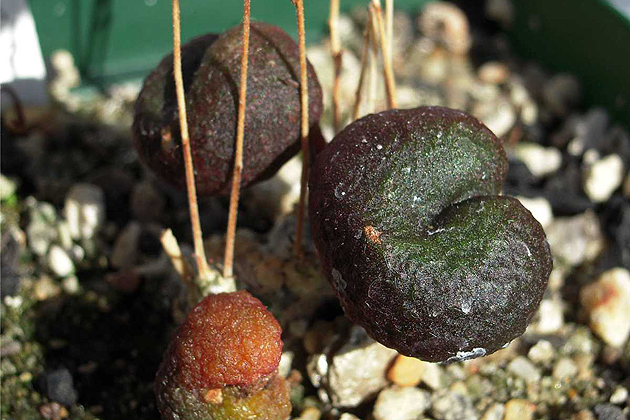
Of all the plants in the ecology and evolutionary biology department (CLAS) greenhouse, there’s one that has particular significance for UConn botanist Matt Opel.
It’s Tylecodon opelii, a tiny plant about 10 mm in diameter that was discovered by Opel during a trip to South Africa in 2000 while he was still a UConn graduate student. After years of study by botanists with expertise in the genus Tylecodon, it has been verified that Opel was the first to identify the plant as a possible new species. Therefore, this mighty mite now officially bears the name, opelii.
Its native habitat is an isolated region of hilly terrain covered in quartz gravel in the northwest corner of South Africa’s Western Cape Province. A hardy, summer-deciduous, dwarf geophyte (a kind of plant having the capability to survive in arid environments by utilizing an underground storage system to retain water), it is so well camouflaged that it’s barely visible in the rugged landscape.

Opel was drawn to this semi-desert region that stretches along a coastal strip of southwestern Namibia and South Africa, and is known as the Succulent Karoo, because of his interest in Conophytums (also known as stone plants) and other succulents. The area is home to about one-third of the world’s approximately 10,000 succulent species, including about 630 species of geophytes.
“I was in an area that I knew would be full of interesting plants” Opel says, “but I wasn’t expecting to find something that hadn’t been seen before. When I first saw these plants I recognized them as being from the genus Tylecodon, but there were some unusual characteristics that caught my eye.”

In particular, Opel was drawn to the plant’s dark green, almost black, leaves that were more rounded than the leaves on most of the other 43 species of Tylecodon that are found in South Africa. “I took photos and also brought some samples back to Ernst van Jaarsveld at the Kirstenbosch National Botanical Garden in Cape Town,” he says. “Botanists there cultivated specimens and made detailed comparisons to related species.”
The process of determining whether or not a plant species is truly ‘new’ involves comprehensive study of its morphology and habitat. The researchers at Kirstenbosch found that, in addition to an unusual leaf structure and color, the plant discovered by Opel has oblong tubers as well as subtle differences in the size and shape of its corolla when compared to other Tylecodon species.
The absence of certain markings that are frequently found in Tylecodons further differentiates it from other members of its genus.

The plants are not especially abundant, and they share space with other quartz gravel species in a region that has a total annual rainfall of only 3 to 5 inches, supplemented by fog that blows in from the cold Benguela currents of the Atlantic Ocean. In an unexpected twist, the Tylecodon opelii flowers during the South African summer when it is leafless and seemingly inert, and is otherwise nearly hidden among the quartz pebbles.
An article written by E.J. van Jaarsveld and Steven Hammer that appeared in the July-August issue of Cactus and Succulent Journal made it official. After years of being studied, the diminutive Tylecodon opelii has passed all the tests that make it a separate species. It continues to grow in the small area of the Succulent Karoo where Opel first spotted it, but it is now cultivated and assured of a permanent place in botanical history.
———————————–
The EEB Greenhouses are located behind the Torrey Life Sciences Building on North Eagleville Road. Visitors are welcome Monday through Friday from 8 a.m. to 4 p.m.



